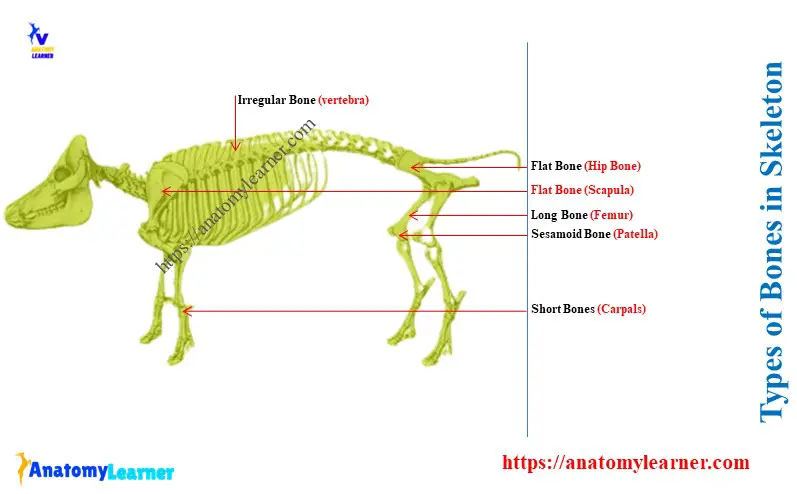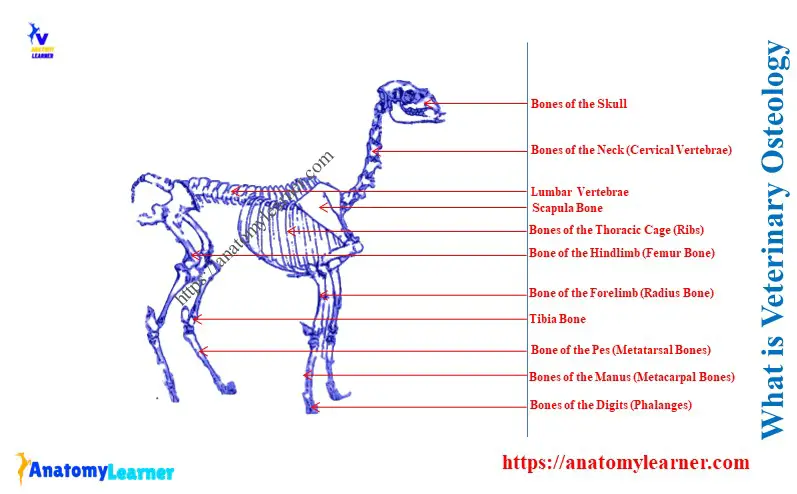The first-year veterinary student starts learning anatomy with osteology. They have the common question – what is the meaning of osteology in veterinary terms?
Quick answer: veterinary osteology is the study of the components of the skeleton or framework of an animal body. Here, the components of the animal skeleton are bones, cartilage, and ligaments.
Here, I will clearly explain osteology with examples in veterinary terms. You will get an overview of the main components of the animal skeleton with the diagram.
What is veterinary osteology?
The word veterinary osteology means the study of the animal’s bones. But, in broad terms, it means the study of the bones, cartilage, and ligaments of the animal skeleton.
Here, the bones, cartilage, and ligaments give the framework of the animal body. This framework of the animal body is known as the skeleton.

Thus, you may define veterinary osteology as follows –
Veterinary osteology is the study of the components of the animal skeleton. Here, the bones are the main components of the animal skeleton.
Table 1 shows the overview of the components that are described in the veterinary osteology –
| Veterinary osteology deals with | Components of osteology |
| Bones of animal | The main components of osteology Hardest structures of the animal body Examples: bones of fore and hind limbs |
| Cartilages | Strong and flexible connective tissue Attach with the bones and protect them Example: scapular cartilage |
| Ligaments | Strong and made of fibrous connective tissue Connect the corresponding bones Works as binding materials in joints Examples: ligamentum nuchae, patellar ligament |
What are the bones in an animal skeleton?
Bones in animal skeletons are the hard structures that give the framework of the body. They not only form the skeleton of animals, but also perform the following functions –
- Provide sufficient surfaces for the attachment of the muscles,
- Protect the vital organs in the thorax, pelvis, and skull of animals,
- They help in the locomotion of the animal, and
- Acts as reservoir of the mineral salts,
The bones of the animal skeleton are divided into –
- Axial skeletons: include the bones of the skull, vertebrae, ribs, and sternum, and
- Appendicular skeletons: include the bones of the forelimb and hindlimb of the animals,
Here, the diagram shows the bones of the animal skeleton. I have already described the number of bones and the specific bones of animals.
You will find different types of bones in the animal skeleton. Some are flat type, some are long cylindrical, some are short, and some are irregularly shaped.
According to the shape and functions of the bones in the animal skeleton, they are divided as follows –
- Flat bones,
- Long bones,
- Short and sesamoid bones, and
- Irregular bones,
Identification of types of bones from animal skeleton
Here, the diagram identifies the different types of bones from the animal skeleton.

Again, Table 2 shows the overview of the features of different types of bones –
| Type of bones in the animal skeleton | Unique features of various bones |
| Flat bones in the skeleton | Flat shaped bone Provide a surface for muscle attachment Examples: scapula, hip bones |
| Long bones in the skeleton | Have elongated cylindrical shaft Have two expanded extremities Examples: humerus, femur bones |
| Short bones in the skeleton | Have smooth surfaces Possess almost similar length, width, and thickness Examples: bones of carpus and tarsus |
| Irregular bones in the skeleton | Have irregular shapes with rough surfaces Locate in the midline of the body Examples: bones of the animal vertebrae |
Flat bones in the animal skeleton
These are the flat, irregular, bony plates of the animal skeleton. Most of the bony plates contain the cavities of the animal that contain essential organs.
These flat bones comprise two plates of compact substances and one layer of intervening spongy substances. The bony plates of the flat bones provide sufficient surfaces for muscle attachment.
Some flat bones of the animal body:
- Scapula bone from the forelimb,
- Hip bones (ilium, ischium, and pubis) from the hindlimb,
- Bones of the animal’s skull,
Long bones of the animal skeleton
These are hollow, long, and cylindrical bones of the animal skeleton. Most of the long bones are found in the limbs of the animal skeleton and act as levers of the body.
The body of the animal’s long bones are cylindrical and possess two expanded extremities. They consist of a tube of compact bone with a medullary cavity.
- Some long bones of the animal skeleton are the humerus, radius, metacarpal, femur, tibia, and metatarsal bones of cow’s skeleton.
- Modified long bones: clavicles of the dog, ribs of the ox.
- Miniature long bones: metacarpal and metatarsal bones of the dogs and cats.
Short bones in the animal skeleton
These are the small bones of the animal joints. They have six smooth surfaces and possess similar dimensions.
- Some short bones in animal skeletons are carpal and tarsal bones.
Sesamoids are also short bones but develop with the capsule or tendon of the joint. They are seed-like bones and work as pully to avoid friction.
Some of the sesamoid bones in the skeleton are the patella, proximal, and distal sesamoid bones in the manus and pes.
Irregular bones in the animal skeleton
These are also small bones but have rough and irregular surfaces. They are found in the midline of the skeleton and have many projections.
These bones are unpaired and composed of both spongy and compact substances.
- Some of the irregular bones of the animal skeleton are cervical, thoracic, lumbar, sacral, and caudal vertebrae.
You will also find pneumatic and visceral bones in the skeletons of the animals. The frontal, maxilla, and ethmoid bones of the skull are the pneumatic bones in mammals.
Conclusion
So, what is the meaning of osteology in veterinary terms was described perfectly. A student might learn the details of the bones, cartilage, and ligaments in veterinary osteology.

